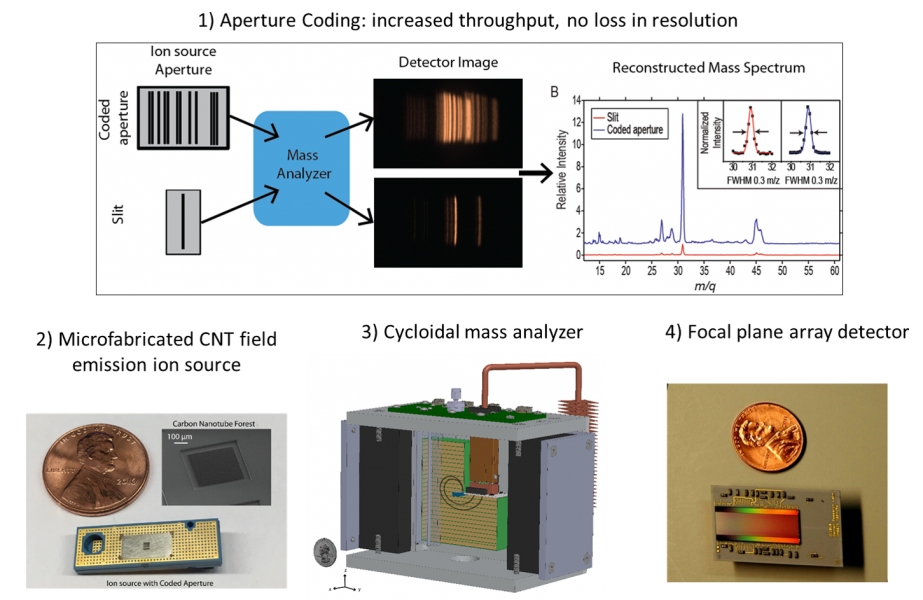The size and cost of traditional mass spectrometers have typically limited their application to laboratory settings. Magnetic sector mass analyzers in particular, while noted for their high mass accuracy, suffer from large size, weight, and power requirements. Miniaturization of mass spectrometers will enable their use in a wide variety of field applications and low-analyte-volume uses. There are three main challenges in mass spectrometer miniaturization:
- When miniaturizing a mass spectrometer, one must confront a throughput vs. resolution tradeoff. In general, when you shrink an instrument, you also have to reduce the throughput to maintain high resolution.
- Reducing high power requirements due to ionization sources and vacuum pumps.
- Limited detector technologies.
To address these limitations, the CAMMS team is combining techniques from computational and compressive sensing with microfabrication to develop high performance miniature mass spectrometers.
We use spatial aperture coding to break the throughput vs resolution tradeoff. Spectroscopic measurements are a convolution of the instrument response and the desired spectrum. Conventional spectroscopic instruments are designed such that the instrument response is a delta function and the measurements are essentially the desired spectrum. However, this design approach can limit the spectrometer performance. I use a different approach by designing the system response to maximize parameters of interest such as throughput and resolution, and then computationally deconvolve the system response from the measurements to achieve a spectrum – thus improving instrument performance. By replacing the slit in a traditional mass spectrometer with a mathmatically designed array of slits called a "coded aperture", we are able to increase the throughput of a mass spectrometer without sacrificing resolution [1].
Cycloidal mass analyzers, developed in the late 1930's have unique "perfect" focusing properties that make them ideal for use with spatially coded apertures. A cycloidal mass analyzer uses perpendicularly oriented electric and magnetic fields. Under the influence of these fields, the ions travel in cycloidal trajectories. The position at which the ions are focused on the detector plane just depends on the mass to charge ratio and the magnitudes of the fields. The focusing properties do not depend on the velocity of the ion making it “perfect focusing”. As such, the cycloidial mass analyzer makes a perfect image of the coded aperture on the detector plane [2].
To reduce power consumption, we develop miniature electron ionization sources based on field emission of electrons from carbon nanotubes. Field emission of electrons consumes several orders of magnitude less power than traditional thermionic filament based electron ionization sources [3].
In addition, to fully realize the advantages of aperture coding in the cycloidal mass analyzer, a focal plane array detector is required. Our collaborators at M. Bonner Denton's group at the University of Arizona have developed a unique capacitive transimpedance amplifier array detector perfect for use with cycloidal mass analyzers and aperture coding [4].

[1]. Amsden, J. J.; Gehm, M. E.; Russell, Z. E.; Chen, E. X.; Dona, S. T. D.; Wolter, S. D., . . . Glass, J. T., Coded apertures in mass spectrometry. Annual Review of Analytical Chemistry 2017, 10, 141-156.
[2]. Amsden, J. J.; Herr, P. J.; Landry, D. M. W.; Kim, W.; Vyas, R.; Parker, C. B., . . . Glass, J. T., Proof of Concept Coded Aperture Miniature Mass Spectrometer Using a Cycloidal Sector Mass Analyzer, a Carbon Nanotube (CNT) Field Emission Electron Ionization Source, and an Array Detector. J Am Soc Mass Spectrom 2018, 29 (2), 360-372.
[3]. Radauscher, E. J.; Parker, C. B.; Gilchrist, K. H.; Di Dona, S.; Russell, Z. E.; Hall, S. D., . . . Amsden, J. J., A miniature electron ionization source fabricated using microelectromechanical systems (MEMS) with integrated carbon nanotube (CNT) field emission cathodes and low-temperature co-fired ceramics (LTCC). International Journal of Mass Spectrometry 2017, 422, 162-169.
[4]. Felton, J. A.; Schilling, G. D.; Ray, S. J.; Sperline, R. P.; Denton, M. B.; Barinaga, C. J., . . . Hieftje, G. M., Evaluation of a fourth-generation focal plane camera for use in plasma-source mass spectrometry. Journal of Analytical Atomic Spectrometry 2011, 26 (2), 300-304.